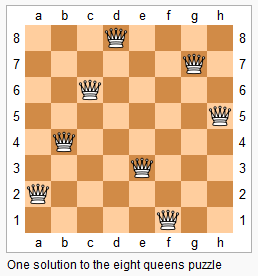The n-queens puzzle is the problem of placing n queens on an n×n chessboard such that no two queens attack each other.

Given an integer n, return the number of distinct solutions to the n-queens puzzle.
Example:
Input: 4 Output: 2 Explanation: There are two distinct solutions to the 4-queens puzzle as shown below. [ [".Q..", // Solution 1 "...Q", "Q...", "..Q."], ["..Q.", // Solution 2 "Q...", "...Q", ".Q.."] ]
AC code:
class Solution {
public:
int totalNQueens(int n) {
int res = 0;
vector<vector<string>> v;
vector<string> nqueens(n, string(n, '.'));
solve(v, nqueens, n, 0, res);
return res;
}
void solve(vector<vector<string>>& v, vector<string>& nqueens, int n, int row, int& res) {
if (row == n) {
res++;
return;
}
for (int col = 0; col < n; ++col) {
if (judge(nqueens, n, row, col)) {
nqueens[row][col] = 'Q';
solve(v, nqueens, n, row+1, res);
nqueens[row][col] = '.';
}
}
}
bool judge(vector<string> nqueens, int n, int x, int y) {
// up and down
for (int i = 0; i < n && i != x; ++i) {
if (nqueens[i][y] == 'Q') return false;
}
// right and left
for (int i = 0; i < n && i != y; ++i) {
if (nqueens[x][i] == 'Q') return false;
}
// left up
for (int i = x-1, j = y-1; i >= 0 && j >= 0; --i, --j) {
if (nqueens[i][j] == 'Q') return false;
}
// right up
for (int i = x-1, j = y+1; i >= 0 && j < n; --i, ++j) {
if (nqueens[i][j] == 'Q') return false;
}
return true;
}
};Runtime: 16 ms, faster than 7.86% of C++ online submissions for N-Queens II.




 本文详细探讨了N皇后问题,即如何在N×N的棋盘上放置N个皇后,使得任意两个皇后不能互相攻击。通过递归回溯算法,实现了N皇后问题的有效求解,并提供了具体的C++代码实现。
本文详细探讨了N皇后问题,即如何在N×N的棋盘上放置N个皇后,使得任意两个皇后不能互相攻击。通过递归回溯算法,实现了N皇后问题的有效求解,并提供了具体的C++代码实现。

















 被折叠的 条评论
为什么被折叠?
被折叠的 条评论
为什么被折叠?








